Transforming the Kenyan Dairy Feeding System through a Communication for Social Change Approach by Patrick Papania et al.
Scaling up development impact is a constant challenge for people working on development projects. Going beyond “islands of success” and reaching hundreds of thousands of beneficiaries often seems an elusive goal. Patrick Papania, senior communications advisor at the Washington, D.C.-based Academy for Educational Development,(AED) with Zachary Fonner, Sam Bringhurst and Laurence Mach, describes a communication for social change methodology known as SCALETM that successfully scaled up a technology transfer by a leading international research organisation to benefit hundreds of thousands of dairy farmers in Kenya, transforming the nation’s small farmer dairy supply chain.
A perplexing question in development work is how to use communication to reach thousands of people—even tens of thousands of people. One communication for social change methodology, known as SCALE™—System-wide Collaborative Actions for Livelihoods and the Environment—has done just that.
Between February 2006 and March 2007, the International Centre for Research in Agro-Forestry (ICRAF), headquartered in Nairobi, Kenya -- in partnership with the United States Agency for International Development (USAID) and its demonstration project, Agricultural Partnerships for Productivity and Prosperity (implemented by AED) -- revealed how SCALE™, in less than two years, could help improve productivity, incomes and livelihoods of 600,000 small-holder dairy farmers in Kenya’s central highlands.
ICRAF, an international nonprofit research organization, had been working in Eastern Africa for two decades to help smallholder dairy farmers raise healthier livestock and produce better quality milk. The organisation knew through research that if small-holder farmers planted three types of fodder shrubs—tricandra, calliandra, and mulberry -- the farmers would have an inexpensive and plentiful source of high-protein animal feed, even during drought seasons.
Fodder shrubs are easy to grow. They improve soil fertility, provide firewood, establish natural borders and control erosion. As they don’t compete with food crops, these shrubs enable farmers to save money they would otherwise have had to spend on dairy meal. Fodder shrubs generate an estimated $100 per cow per year from increased milk production, dramatically increasing revenues for farmers, seed dealers, milk collectors and other dairy value chain stakeholders.
ICRAF’s challenge in scaling up was communicating the benefits of fodder shrubs to significant numbers of farmers and other stakeholders. In the eight years before employing SCALE™, the organisation had only been able to reach 48,000 farmers. This “islands of success” achievement was not enough. According to Steve Franzel, one of ICRAF’s principal scientist-agricultural economist, the big problem was, “how to communicate, how to spread the use of these practices across very large areas?”
The solution for ICRAF proved to be SCALE™.
Overview
SCALE™ is a five-step, communication-driven management process based on field experience gathered through many years of extension work, including the efforts of GreenCOM, a USAID-funded environmental education and communication project implemented in 30 countries over 13 years.
SCALE™ applies multiple social change methods to engage a broad array of stakeholder groups in actions that support common goals.
The SCALE™ process comprises five steps:
- Map the context
- Catalyse coalitions and partnerships;
- Create collaborative, sustainable solutions;
- Act; and
- Value.
Step One: Mapping the Context
In this step, community representatives define and understand the larger “system” around a development goal by identifying the multiple stakeholders linked to the issue from environmental, economic, governance and social sectors.
In February 2006, ICRAF formed a nine-person advisory committee to map the context and plan for a partnership-building workshop. The committee decided to bring together all relevant stakeholders to support “enriched-feeds for improving the productivity and incomes of smallholder dairy farmers.” Committee members, led by an AED/ICRAF team using the SCALE™ methodology, worked on inviting the right mix of stakeholders—private, civil society, governmental and environmental—to the workshop.
Step Two: Catalysing Coalitions and Partnerships
The team invited more than 100 people to a “Whole-System-in-the-Room” (WSR) workshop in Nairobi at the Kenya School of Monetary Studies in early March 2006. One hundred fifteen diverse participants from assorted stakeholder groups in the value chain, including the private, civil society, governmental and environmental sectors, shared their vision for enriching cattle feed to increase milk production and created collaborative action plans to achieve their common goals at this event.
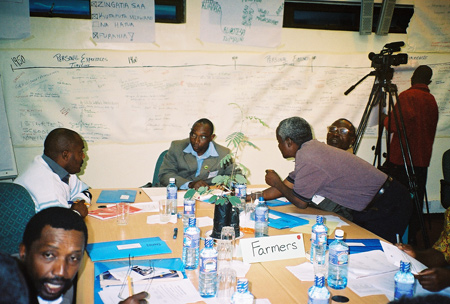
The workshop encouraged discussions in which all participants—farmers, dairy transporters, buyers, distributors, researchers, media representatives, government institutions, NGOs and advertising agents—had an equal voice. The discussions generated practical ideas for change and helped participants find common ground in order to forge relationships that would drive the change process for months to follow.

During the workshop, participants discussed the best ways to enrich cattle feed and increase milk production. According to Esther Karanja, an AED/ICRAF team member, “There were no technical presentations, and everybody’s idea was valued. So this helped people speak out. They gave out ideas that would be valuable to the entire system.”
After several days of working together, the participants had identified common objectives as well as common solutions—short- and medium-term collaborative action plans. On the last day of the workshop, more than 60 participants stood up and made commitments to their peers of what they would personally do to help achieve the established common goals.
Steps Three and Four: Creating Collaborative, Sustainable Solutions and Acting
In the following months from March to September 2006, participants acted on the commitments they had made during the workshop. The AED/ICRAF team supported the action plans, focusing on common goals in which it could rally technical expertise and experience from within the system.
Using a combination of communication channels, the team worked to improve communication about fodder shrubs and other enriched-feeds.
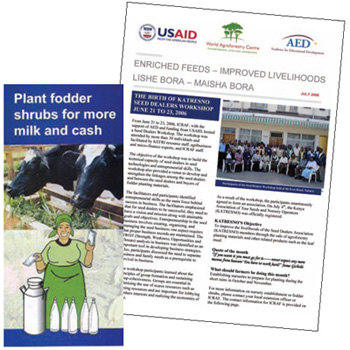
The AED/ICRAF team produced simple, low-cost print materials providing basic information on feeding system topics as well as bi-monthly newsletters, distributed electronically and in print, providing progress reports, recognition of model farmers and contact information for fodder shrub seed dealers. They made regular phone calls to stakeholders to encourage on-going collaboration and kept an event log to track collaborative actions.
Building on the participation of media representatives in establishing common goals at the WSR workshop, the team established an awards program for media coverage, offering modest prizes, most of which were donated by local businesses, for the best print, radio and TV coverage of fodder shrub activity. It organised field trips for media reporters to provide eye-witness experiences of farmers’ challenges and successes with fodder shrubs.
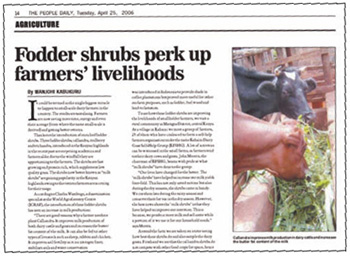
The result was a bonanza of free advertising for the program—stories in newspapers, radio and TV. Enriched-feed specialists appeared on national and local live radio broadcasts; listeners called in to ask questions or tell their success stories. The Kenya Broadcasting Corporation and Citizen TV developed documentaries that were used on television talkshows, in workshops, presentations, and other meetings to increase awareness about fodder shrubs.
During this period, the AED/ICRAF team also worked to strengthen communication and collaboration among WSR participants and new stakeholders. They sponsored a series of regional outreach and networking meetings to increase stakeholder involvement, improve flow of information, and encourage exchanges between stakeholder groups.
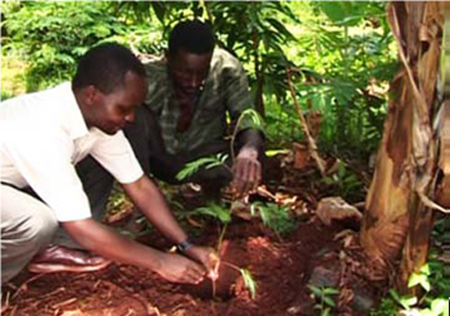
People from different stakeholder groups worked together creating bonds that enhanced knowledge transfer. Above, Charles Wambugu of the ICRAF team and a Kenyan dairy farmer review the best way to plant fodder shrubs.
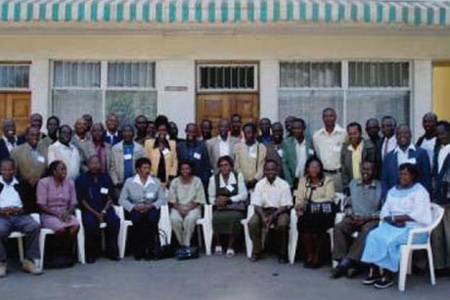
The mobilisation of seed dealers into an organised association was key for the success of SCALE™. In June 2006, at an ICRAF workshop in Nakuru, Kenyan seed dealers formed the KATRESNO Seed Dealers Association. Dealers began collaborating around their efforts to convey knowledge to farmers growing fodder for feed.
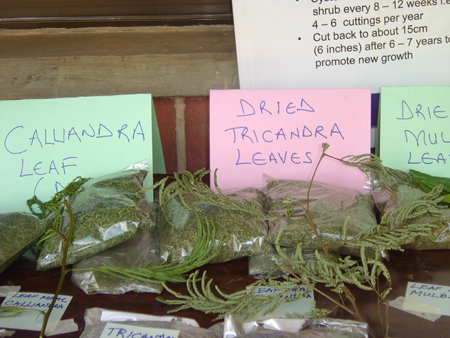
Within a year of using SCALE™ in the Kenyan small- holder dairy feeding system, dealers had distributed more than 2,300 kilograms of Calliandra seed and 370,000 seedlings. Seed and seedling sales from only one-third of the KATRESNO seed dealers enabled 112,000 smallholder farmers to adopt fodder shrubs, according to ICRAF estimates.

As essential stakeholders and important members of the dairy industry, collectors and buyers of milk were eager to get involved by distributing information and educating farmers in better milk production strategies. As one dairy processor put it, “We will encourage them (dairy farmers) as much as we can to grow these fodder shrubs so that we are also assured of a constant supply of quality milk.” Encouraging and enabling the entire system to engage in the extension of fodder technology allowed for wide impact and large-scale results.

Thanks to SCALE™, the entire dairy supply chain has improved. Farmers, nursery owners and dairy processors all reported increased productivity and improved communication. Significantly increasing the number of dairy farmers planting fodder shrubs increased incomes and supported the transformation of livelihoods throughout Kenya’s central highlands.
Step five: Value
Due to the short duration of the demonstration project, evaluation of the program’s success focused primarily on intermediate outcomes and short-term indicators. The intermediate outcomes included:
- An increased number of stakeholders engaging in collaborative, sustainable actions towards common-ground goals.
- Strengthened communication and working relationships among stakeholders.
Results
Using evaluation tools such as a collaborative action log, a media log and semi-structured interviews with value chain opinion leaders, the success of SCALE™ in Kenya included:
- Reaching, in thirteen months, more than triple the number of farmers ICRAF had reached in the previous eight years;
- Creating a viable private sector partner in seed distribution—the first Kenyan national fodder shrub seed dealer association;
- Generating extensive unpaid media coverage of the benefits of fodder shrubs which encouraged more farmers to plant them;
- Significantly strengthening the dairy enriched-feeding system; and
- Creating a system inclusive of both genders in which knowledge transfer has been made available for all.
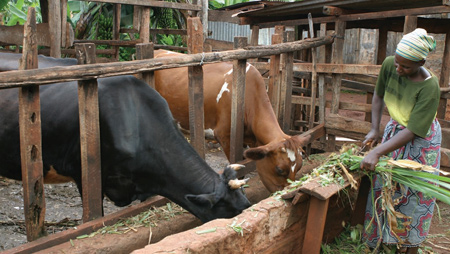
More than half of the subsistence farmers in Africa are women. Consequently, teaching improved farming techniques to women, as well as men, empowers and encourages them to take a pro-active role in development at the household level. Moreover, empowering women leads to progressive change and increases the capacity of society simultaneously.
For more information:
http://www.aed.org/Publications/upload/Kenya_Case_revised_020608.pdf


